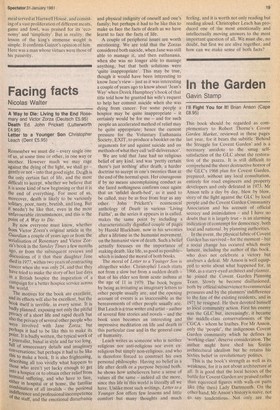In the Garden
Gavin Stamp
I'll Fight You for It! Brian Anson (Cape e8.95) This book should be regarded as complementary to Robert Thorne's Covent Garden Market, reviewed in these pages last year, for it bears the subtitle 'Behind the Struggle for Covent Garden' and is a necessary 'antidote to the smug selfsatisfaction of the GLC about the restoration of the piazza. It is . still difficult to comPrehend the sheer destructive horror of the GLC's 1968 plan for Covent Garden, prepared, without any local consultation, entirely for road engineers and property developers and only defeated in 1971 Mr Anson tells a day by day, blow by blow, story of the fight against the GLC by local people and the Covent Garden Community Association and his account of official secrecy and intimidation and 1 have no doubt that it is largely true is an alarming indication of contempt for democracy, both local and national, by planning authorities.
In the event, the physical fabric of Covent Garden has survived for the moment but a social change has occured which many lament, including the author of this hook, who does not celebrate a victory but analyses a defeat. Mr Anson is well equipped to write about what happened for, in 1966, as a starry-eyed architect and planner, he joined the Covent Garden Planning Team. Slowly he became disillusioned, both by official subservience to commercial pressures and by the planners' indifference to the fate of the existing residents, and in 1971_ he resigned. He then devoted himself to local community action. First his enemy was the GLC but, increasingly, it became the middle-class conservationists of the CGCA whom he loathes. For Mr Anson, only the 'people', the indigenous Covent • Garden community which he defines as 'working-class', deserve consideration. The author might have shed his Sixties architectural idealism but he retains his Sixties belief in revolutionary politics.
This is the book's strength as well as its weakness, for it is not about architecture at all. It is good that the local heroes of the battle for Covent Garden are praised rather than equivocal figures with walk-on parts like (the then) Lady Dartmouth. On the other hand, Mr Anson's history is naive, not to say tendentious. Not only are the construCtive roles of outsiders like Geoffrey Rippon — who listed half the buildings and so sabotaged the plan — underplayed, but in an attempt to see four centuries of workingclass occupation in Covent Garden, other residents are belittled and the longstanding existence of the Royal Opera House is ignored.
This book is bitter about the failure of working-class community action. It is also apologetic to all the people Mr Anson would seem to have quarrelled with in fighting for his political, i.e. Marxist, view of preservation. It would be easy to ridicule much of his text — the irresponsible comparison between Covent Garden and 'Free Derry', the sentimental and exclusive reverence for working-class culture, the revolutionary utopianism — but all the same, there, is much said in this book that needs saying. The truth is that most of the indigenous locals have been forced out, whether by eviction or rising rents. Where there were once greengrocers and tobacconists, now there are clever boutiques and craft shops.
But this phenomenon is not peculiar to Covent Garden. The sad fact is that once a particular area becomes of interest to planners and developers, whether preservation or redevelopment wins, local people, small shops and small businesses are still forced out. Mr Anson sees the enemy always as capitalists (never really confessing the architect's lust for power which must have gripped him back in 1966). But the same effect has often been achieved by Socialist councils, such as those which decanted people from Bethnal Green to Roehampton after 1945. Mr Anson's book describes a particular example of what is a more general phenomenon, and it is one which we should all oppose. For a city that does not have cheap accommodation in the centre is not only unhealthy; it is also expensive and inconvenient. It helps nobody if the excellent people who run public transport, or work in markets, or who clean, or who are waiters, have to live miles away because of property values. Yet this obvious fact did not seem to strike the planners of the post-war decades nor has yet sunk in to the councillors of Westminster, or Southwark, or the GLC. We make London like Birmingham at our cost. Judging from cities behind the Iron Curtain, nationalisation of land is not necessarily the answer to this problem; in Covent Garden both developers and local authorities owned too much land between them and I think Mr Anson is right to conclude that it was only the less favourable economic circumstances in the early 1970s that really saved the area.
Although I do not share the author's prejudices or politics and do not admire his vulgar And careless style. I end by being very sympathetic to this book. I, too, loved Covent Garden as it was and regret the recent changes: not because I believe only 'working-class' culture is important but because I dislike seeing any individual forced out of his home by arrogant authority or by artificial financial pressures. This is a book which ought to be read by anyone who loves London and who wishes to understand the forces for urban change.







































 Previous page
Previous page